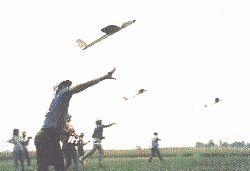There are no tricks
Optimizing electrics
We've all seen them. A slow electric sailplane, straining desperately for altitude. Unimpressive.
 But what about an electric Q-500 pylon racer screaming silently in excess of 100 mph? Or a 1/4 scale Cub silently and majestically sweeping into the air, or a 1/5-scale Laser flying the complete FAI pattern repertoire? Or vertically hand-launching a 2-meter sailplane, flying out of sight in mere seconds? This is what electric RC flight is really all about, and it's very do-able with off-the-shelf equipment.
But what about an electric Q-500 pylon racer screaming silently in excess of 100 mph? Or a 1/4 scale Cub silently and majestically sweeping into the air, or a 1/5-scale Laser flying the complete FAI pattern repertoire? Or vertically hand-launching a 2-meter sailplane, flying out of sight in mere seconds? This is what electric RC flight is really all about, and it's very do-able with off-the-shelf equipment.
So what's wrong with our struggling sailplane?
Usually, such planes are constructed from kits with cheap kit-supplied
tin can motors. They cost $5-10 and are essentially throw-aways. But
they're a great marketing gimmick, and they're cheap! Also, frequently
the modeler "overbuilds" the plane, and so it weighs a few ounces more
than it should. Combine this (typically 3 lb) airplane with a weak 90
watt (.049 gas equivalent) motor, and it's no wonder that the plane
flies sluggishly. Using a high-performance cobalt or ferrite motor,
using lightweight radio equipment and lightening the structure will
make ALL of the difference.
Building a Good Electric Plane
Because NiCad batteries for electric motors are heavier than fuel tanks for gas planes, in order to achieve good performance from electrics, some care must be taken to minimize the weight of the structure of the airplane. Fortunately, most gas plane kits are hideously overbuilt. Thus one can reduce the structural weight of the plane so that the electric plane will not be significantly heavier than the gas plane.
Often the structure can be lightened 50% since electrics do not exhibit significant vibration and do not need to be fuel-proofed. Coupled with lightweight radio equipment and cobalt motors, electrics can yield identical performance to their gas-powered counterparts.
When building a model, question the role of every piece of wood. Could you remove the piece entirely or construct it out of lighter materials? The adage "build strong where needed, and build light everywhere" should be foremost on your mind. Remember, a lighter plane flies better -- and a lighter structure does not mean a weaker plane!
Props, Gearing?
Using an appropriate propeller can yield drastically improved results. Remember, an electric motor will yield more power as you increase the load. Thus, increasing the pitch or diameter of the prop will draw more current and generally more thrust. Using a more efficient prop will also help (I use APC props; Graupner props are also good but may be difficult to find).
If the plane is a slow flier, a geared motor will yield more efficient thrust than a direct drive motor. Conversely, a fast sport plane or pylon racer should be using a suitable direct drive motor.
Back to the
High Voltage! page
 But what about an electric Q-500 pylon racer screaming silently in excess of 100 mph? Or a 1/4 scale Cub silently and majestically sweeping into the air, or a 1/5-scale Laser flying the complete FAI pattern repertoire? Or vertically hand-launching a 2-meter sailplane, flying out of sight in mere seconds? This is what electric RC flight is really all about, and it's very do-able with off-the-shelf equipment.
But what about an electric Q-500 pylon racer screaming silently in excess of 100 mph? Or a 1/4 scale Cub silently and majestically sweeping into the air, or a 1/5-scale Laser flying the complete FAI pattern repertoire? Or vertically hand-launching a 2-meter sailplane, flying out of sight in mere seconds? This is what electric RC flight is really all about, and it's very do-able with off-the-shelf equipment.